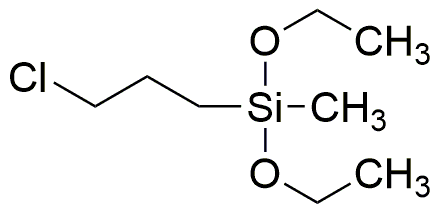3-Chloropropylmethyldiethoxysilane is widely utilized in research focused on:
- Adhesive Formulations: This compound enhances the bonding strength of adhesives used in construction and automotive industries, providing superior durability and resistance to environmental factors.
- Surface Modification: It is effective in modifying surfaces of materials like glass and metals, improving their hydrophobic properties and resistance to corrosion, which is crucial in electronics and automotive applications.
- Coatings and Sealants: Used in the production of protective coatings, it offers excellent water repellency and chemical resistance, making it ideal for outdoor applications such as roofing and marine coatings.
- Silane Coupling Agents: This chemical acts as a silane coupling agent, enhancing the compatibility between organic and inorganic materials, which is beneficial in composite manufacturing and improving material performance.
- Biomedical Applications: In the biomedical field, it is used for surface functionalization of implants and medical devices, promoting better biocompatibility and reducing the risk of rejection by the body.
General Information
Properties
Safety and Regulations
Applications
3-Chloropropylmethyldiethoxysilane is widely utilized in research focused on:
- Adhesive Formulations: This compound enhances the bonding strength of adhesives used in construction and automotive industries, providing superior durability and resistance to environmental factors.
- Surface Modification: It is effective in modifying surfaces of materials like glass and metals, improving their hydrophobic properties and resistance to corrosion, which is crucial in electronics and automotive applications.
- Coatings and Sealants: Used in the production of protective coatings, it offers excellent water repellency and chemical resistance, making it ideal for outdoor applications such as roofing and marine coatings.
- Silane Coupling Agents: This chemical acts as a silane coupling agent, enhancing the compatibility between organic and inorganic materials, which is beneficial in composite manufacturing and improving material performance.
- Biomedical Applications: In the biomedical field, it is used for surface functionalization of implants and medical devices, promoting better biocompatibility and reducing the risk of rejection by the body.
Documents
Safety Data Sheets (SDS)
The SDS provides comprehensive safety information on handling, storage, and disposal of the product.
Product Specification (PS)
The PS provides a comprehensive breakdown of the product’s properties, including chemical composition, physical state, purity, and storage requirements. It also details acceptable quality ranges and the product's intended applications.
Certificates of Analysis (COA)
Search for Certificates of Analysis (COA) by entering the products Lot Number. Lot and Batch Numbers can be found on a product’s label following the words ‘Lot’ or ‘Batch’.
*Catalog Number
*Lot Number
Certificates Of Origin (COO)
This COO confirms the country where the product was manufactured, and also details the materials and components used in it and whether it is derived from natural, synthetic, or other specific sources. This certificate may be required for customs, trade, and regulatory compliance.
*Catalog Number
*Lot Number
Safety Data Sheets (SDS)
The SDS provides comprehensive safety information on handling, storage, and disposal of the product.
DownloadProduct Specification (PS)
The PS provides a comprehensive breakdown of the product’s properties, including chemical composition, physical state, purity, and storage requirements. It also details acceptable quality ranges and the product's intended applications.
DownloadCertificates of Analysis (COA)
Search for Certificates of Analysis (COA) by entering the products Lot Number. Lot and Batch Numbers can be found on a product’s label following the words ‘Lot’ or ‘Batch’.
*Catalog Number
*Lot Number
Certificates Of Origin (COO)
This COO confirms the country where the product was manufactured, and also details the materials and components used in it and whether it is derived from natural, synthetic, or other specific sources. This certificate may be required for customs, trade, and regulatory compliance.


